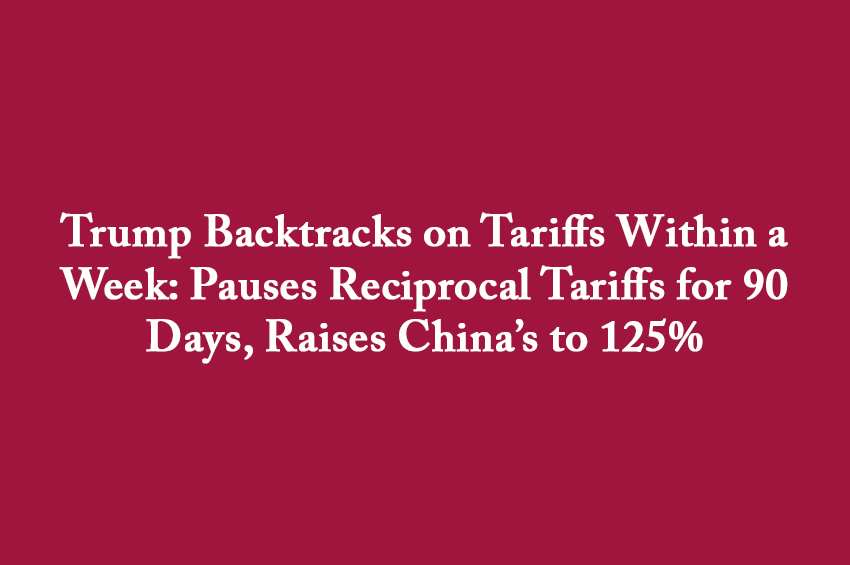Tariff Pause for Over 75 Countries, China Excluded
Winning Bizness Desk
Mumbai. In a sudden shift within just seven days of his aggressive tariff announcement, former US President Donald Trump has put a 90-day pause on reciprocal tariffs for over 75 countries. However, China has been excluded from this relaxation. Instead, tariffs on Chinese goods have been raised from 104% to a steep 125%. Trump cited China’s retaliatory 84% tariff and its disregard for global market norms as key reasons for this hike. The increase means that a $100 product made in China will now cost $225 in the US, potentially lowering demand and sales of Chinese goods in the American market.
Trump’s Strong Rhetoric Against China
In a post on Truth Social, Trump lashed out at China, saying it had shown disrespect to the global market. “The days of looting America and other countries are over,” he declared while justifying the tariff increase. While he extended a 90-day pause to most countries to allow room for trade negotiations, he made it clear that China would not enjoy any such concession due to its hostile trade actions. Trump said countries willing to negotiate would see tariffs drop to a base level of 10%.
Domestic Pressure and Economic Fallout Prompted U-Turn
Trump’s reversal appears to be influenced by growing domestic and economic pressure. His own advisors, Republican lawmakers, and business leaders like Elon Musk had voiced concerns over the economic fallout. Wall Street banks warned of inflation, job losses, and an impending recession if the trade war continued. Massive bond sell-offs, falling crude prices, and a global market plunge of over $1 trillion had raised alarms. The pause in tariffs triggered a swift market rebound, with the US stock market gaining $310 billion in value within hours of the announcement.
Markets Rally After Tariff Pause
Soon after Trump’s announcement, US markets surged. The Dow Jones jumped over 2,600 points (7.1%), the S&P 500 rose by 9.5%, and the Nasdaq surged 10.3% — its biggest single-day gain since the 2008 recession. Shares of major companies like Tesla, Nvidia, and Apple recorded sharp gains, with Tesla leading the rally with a 20.01% spike. Bitcoin also rose by 6%. This rebound followed a sharp global selloff a day earlier, triggered by fears over the intensifying tariff war.
China Responds with Firm Resistance
China responded to Trump’s move by vowing to resist US pressure. Chinese Foreign Ministry spokesperson Mao Ning stated that China would not bow down and would fight till the end. He posted a video of former Chinese leader Mao Zedong from the 1953 Korean War era, emphasizing China’s resolve to never surrender under pressure. Mao Ning also shared images suggesting that despite higher prices, US consumers would still buy Chinese products due to lack of alternatives and brand loyalty.
China Focuses on Industrial Strength and Innovation
In preparation for prolonged trade tension, China is investing heavily in domestic industry and technology innovation. It has issued $1.9 trillion in additional loans to strengthen its industrial sector. Huawei has opened a massive R&D center in Shanghai for 35,000 engineers, ten times the size of Google’s California headquarters. These investments signal China's strategy to reduce dependence on US-linked supply chains and assert itself as a tech powerhouse. Meanwhile, China continues to hold approximately $760 billion in US treasury bonds, giving it significant leverage.
10 Key Points:
1. Trump paused reciprocal tariffs for 90 days for 75+ countries but excluded China.
2. Tariffs on Chinese goods were raised from 104% to 125%.
3. Trump's move followed China’s retaliatory tariff hike to 84%.
4. A $100 Chinese product will now cost $225 in the US due to the tariff.
5. US markets surged post-announcement; Dow rose 2,600 points.
6. Tesla’s stock jumped over 20%, Nasdaq saw the biggest gain since 2008.
7. Trump cited economic damage and political pressure for the poicy reversal.
8. Republican leaders and Elon Musk had criticized the original tariff move.
9. China is boosting innovation, industrial loans, and R&D to counter trade pressure.
10. China vowed to resist, saying it would never surrender under US pressure.


